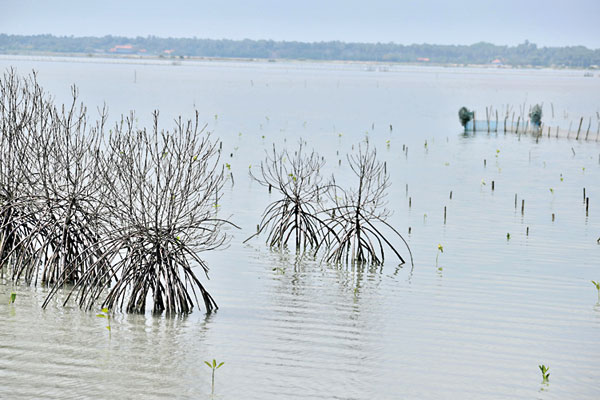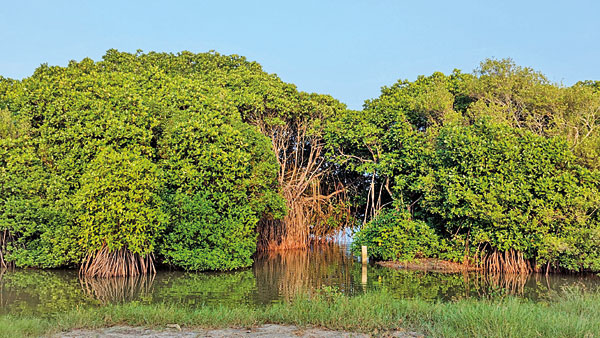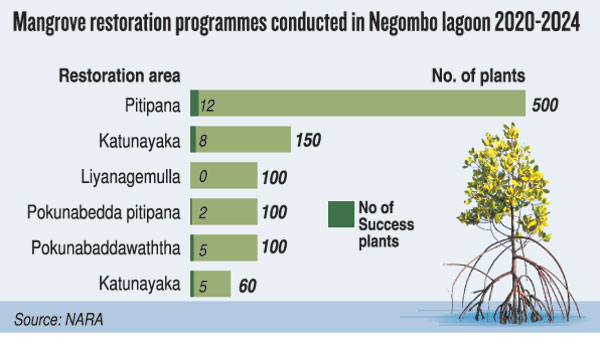News
Overdoing mangrove restoration has downside
View(s):By D. Thiviyatharshini
In earlier times, people overexploited mangroves for their use all over the country. It eventually caused mangrove degradation. So mangrove restoration became essential.
Over time, it may become a tradition to plant mangroves without adequate scientific research. Many developed countries offset their carbon emissions by planting mangroves in Sri Lanka.
Most NGOs support this practice by promoting the concept of blue carbon.

The current situation in Ponnalli and healthy mangrove (right)
Restoration of an ecosystem is functional, but if done erratically, it can lead to a disaster. So public concern and scientific background studies play an important role in restoring the ecosystem properly.
According to Prof. Sevvandi Jayakody, chairperson, National Mangrove Expert Committee, some investors are interested in planting mangroves here, but the coastline is only 1,400 kilometres.
“It’s crucial to conserve our existing healthy mangrove patches and focus on proper scientific restoration without sacrificing other ecosystems. Restoration, in the sense, reviving lost plant and animal species through suitable scientific methods that align with societal norms, is essential for re-establishing ecosystems, benefiting countries and communities with renewed ecosystem services.
“There is no point in bringing the mangroves from the south to the northwestern coast to plant. Each plant has its own genetic identity. We should not do genetic pollution,’’ said Prof Jayakody.

Some communities have been promised payment for collecting mangrove seed and are collecting immature seeds, which are transported across the country. Most probably, it will lead to genetic pollution.
In the early 80s and 90s, the people didn’t know about mangroves and it was just used for logging, shrimp farming and salt making. In the early 2000s, people began to recognise mangroves for their role in protecting shorelines and combating climate change, especially with concerns about sea level rise. Their ability to sequester carbon highlights their importance in mitigating climate change.
However, significant degradation has occurred, with efforts crucial to address these changes. All mangroves in our country are native, and we also have associated mangrove plants.
According to Prof. Jayakody, the distribution of mangroves across the country should be mapped, so the sites where mangroves have been lost can be identified. “Also, remember that not everything that is lost can be restored, where either some of them are still under recovery, or else they were converted into the new ecosystem that doesn’t want to be disturbed anymore.
“The Ministry of Environment developed national guidelines for mangrove restoration, outlining best practices and providing a comprehensive approach to restoration efforts. Since the National Guidelines also clearly provide guidelines on how to identify what to plant and what not to plant.
“According to the guideline, in the pioneer stage, data collection is a mandatory part. The abiotic components include water, soil, and sediment. The biotic components include plants and animals. It has given an idea about the type of data to be maintained.’’
Sri Lanka has adopted a technique called ‘accelerated natural regeneration’ of mangroves.Prof. Sevvandi said. “So it is our responsibility to accelerate natural regeneration. We can speed up the process by managing lost water. This may involve breaking dikes and dams to allow water and sediments to flow in, and possibly recreating a canal system or water channels.

“On the other hand, along the coastline excluding mangroves, there are dynamic ecosystems such as salt marshes, lagoon fronts, estuary fronts, river mouths, mudflats, sea grasses, and sand dunes.
“Many non-governmental agencies and individuals are mistakenly planting mangroves in inappropriate areas like seagrass beds, mudflats, and salt marshes for financial gain. This is problematic, especially since we are situated in a key migratory bird route, including the eastern flyway, where these birds rely on mudflats as their main feeding grounds.
“In the lagoons, in the middle of the water, some organisations have gone and planted mangroves. If it continues, they will result in shrinking the size of the lagoon and impact the fishery and landing site.
“In the Anawilundawa restoration site, which is managed by the Department of Wildlife Conservation and the Department of Forests. They have recruited young scientists, and they have invested in checking the water quality, which can be used for further proceedings,’’ said Prof. Sevvandi. So it is evident that the proper scientific restoration was done by officials.
“Naturally, a tree can produce a number of saplings. When they fall, only a few will mature. The rest is food for animals of the ecosystem. When we are removing the particular saplings from the area, it will disturb the food web as well.’’
Mangrove plants are getting tied up with carbon credit systems. In Sri Lanka, many agencies and individuals are trying to do illegal and unscientific planting. Then they are going to claim this carbon credit and move forward with it.
Monitoring, evaluating, and following the rules and regulations in mangrove restoration is mandatory. For the proper restoration practices, contacting the Department of Wildlife Conservation, the Ministry of Environment, the National Expert Committee, and Blue Carbon Power Support will give additional technical support.
“Starting from 1990, we did much research on mangrove restoration, and from 2016 to 2017, we researched Ponnalli, Jaffna, where we can see the poor growth and survival rates,” said Maryanathan Edison, coastal and marine environmentalist.
This research is evidence of the failure of unscientific restoration. He said the Ministry of Environment has published the national guidance of mangrove restoration. This particular procedure is too long, which is why people and NGOs refuse to go through the particular procedure.
He highlighted that, while starting restoration, they say there were no mangroves here and that they don’t have the data. If there are no mangroves in that particular place, then why are they restoring it? So, before starting, they should go for the district-level analysis and study the background. Local people are also very much concerned about preserving the mangroves without the interruption of NGOs and government departments, he said.
“For example, some of the research published shows that particular mangroves are found in Mannar, which do to exist. This particular data will become a misinterpretation of future findings. When researching a particular subject, we should also be more precise, otherwise it will become the wrong basis,’’ he said.
“We are currently doing a restoration project, initiated in 2021, with the collaboration of Coast Conservation and Coastal Resource Management Department (CCD) and a Singapore company that aims to restore 3,000 hectares, in three phases,” said Thushan Kapurusinghe, chairman, Turtle Conservation Project.
It includes the districts of Puttalam, Kilinochchi, Mullaitivu, Trincomalee, Ampara, and Batticaloa. They used the community-based organization, the fishery cooperative societies, to collect the seedlings. It is a corporate social responsibility project.
According to Mr Kapurusinghe, there is a 75% success rate, and this is the first carbon financing project in Sri Lanka. Sri Lanka acts as the carbon financing centre for the countries in Europe and America, which are the main contributors to air pollution.
He also mentioned that former president, Maithiripala Sirisena, while attending a conference, promised to the global community that Sri Lanka would plant an additional 10,000 hectares of mangroves by 2030.
This emphasises the unnecessary pressure on mangrove restoration.
The National Aquatic Resource Research and Development Agency (NARA) said that from 2020 to 2024, the success rate of mangrove restoration in Negombo declined dramatically. (See data in graph)
“We are working via 13 regional offices, the main threat to these places is dumping demolition waste,” said the Marine Environment Protection Authority.
Not only global pressure but also the careless behavior of the people causes destruction to the restoration process.
“National guidelines must be followed, regardless of whether they are from the government, NGOs, or scientific backgrounds,” said Prof. P. B. Terney Pradeep Kumara, director general, CCD.
According to Prof. Terney, some NGOs justify planting mangroves in lagoons by claiming that they are increasing blue carbon. “Jungles are important ecosystems, and we cannot convert the entire country into a jungle. Similarly, restoring mangroves beyond the limit will result in disaster. So, improvement of restrictions in restoring the mangrove, as well as the scientific background study of the particular ecosystem is mandatory.’’
The best way to say that you found the home of your dreams is by finding it on Hitad.lk. We have listings for apartments for sale or rent in Sri Lanka, no matter what locale you're looking for! Whether you live in Colombo, Galle, Kandy, Matara, Jaffna and more - we've got them all!

